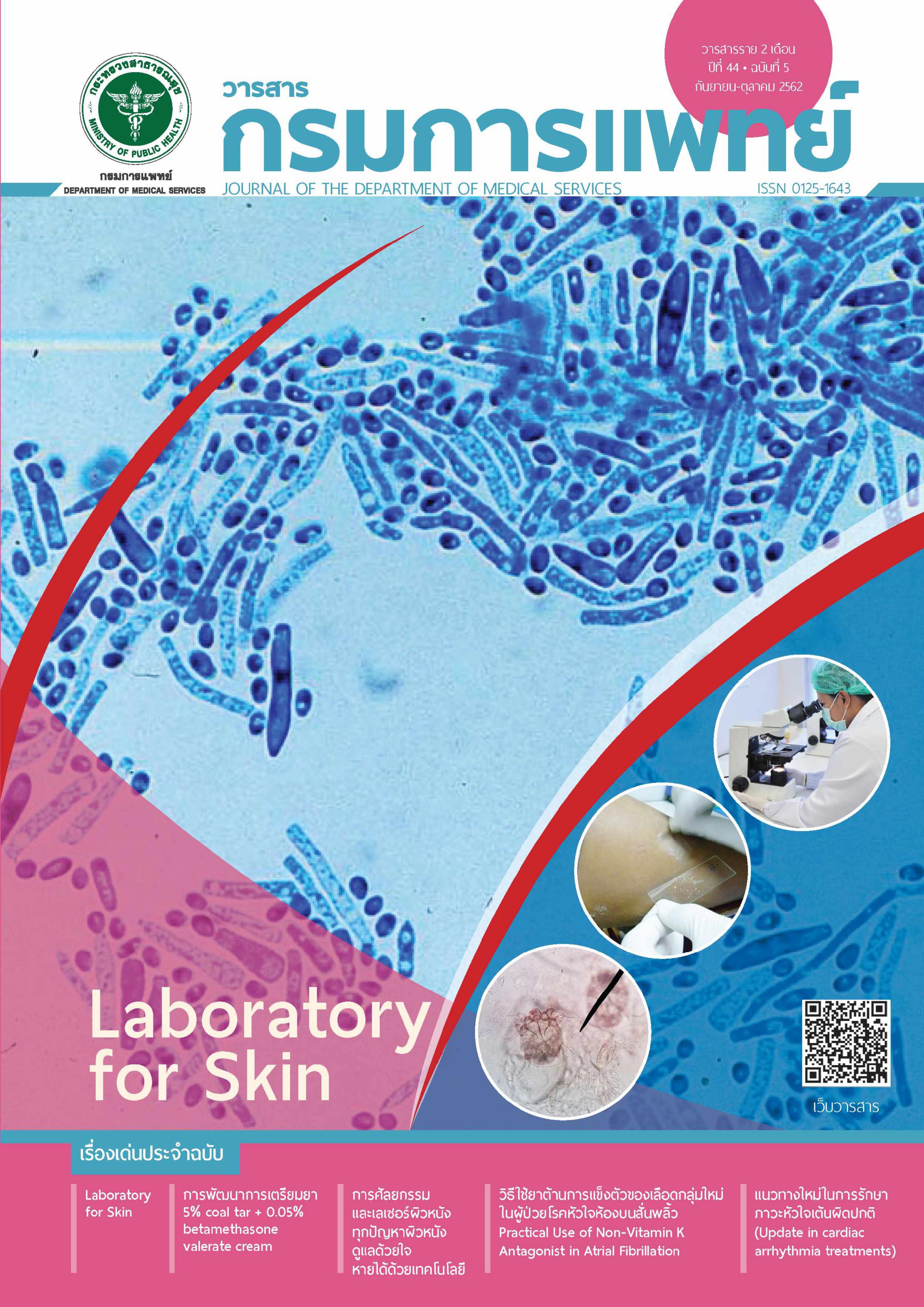Relative Risk Factors of Abnormal Endometrial Pathologies in Patients with Abnormal Uterine Bleeding
Keywords:
Abnormal uterine bleeding, Endometrial hyperplasia, Endometrial cancerAbstract
Objective: To evaluate the association of risk factor (s) with endometrial hyperplasia and carcinoma among women with abnormal uterine bleeding (AUB) at Ratchaburi Hospital.
Method: A retrospective observational analytical cross-sectional study. The data was collected from patient record 270 patients who had undergone endometrial curettage due to AUB during 1st October 2016 to 30th September 2018. To study demographic data (age, BMI, underlying disease, parity and hormonal used) compared factors in normal endometrium (n=216) and abnormal endometrium (n=54).
Result: Of 1,496 AUB patients, the prevalence in pre-menopause was 87.5% and post-menopause was 12.5%. AUB patients underwent endometrial curettage (18.05%). The most common endometrial pathology in pre-menopause AUB was proliferative endometrium (27.27%). Abnormal endometrial pathology in pre-menopause was found in 10.3%. The most common endometrial pathology in post-menopause was atrophic endometrium (40.01%). Abnormal endometrial pathology in post-menopause was found in 35.24%. Relative risk of endometrial hyperplasia and carcinoma in nulliparity, post-menopause, diabetes, metabolic syndrome, hypertension and obesity among women with AUB were 7.44, 4.74, 3.65, 3.57, 3.33 and 2.88 respectively.
Conclusion: Nulliparity, post-menopause, diabetes, metabolic syndrome, hypertension and obesity have been significantly related to abnormal endometrial pathologies in patients with AUB.
References
Munro M, Critchley H, Broder M, Fraser ID. FIGO classification system (FIGO-COEIN) for causes of abnormal uterine bleeding in nongravid women of reproductive age. Int J Gynaecol Obstet 2011; 113: 3-13.
Fraser I, Langham SU-HK. Health-related quality of life and economic burden of abnormal uterine bleeding. Expert Rev Obstet Gynecol 2009; 4 : 179–89.
Shapley M, Jordan KCP. An epidemiological survey of symptoms of menstrual loss in the community. Br J Gen Pract 2004; 54: 359–63.
Garside R, Stein K, Wyatt K, Round APA. The effectiveness and cost-effectiveness of microwave and thermal balloon endometrial ablation for heavy menstrual bleeding: a systematic review and economic modelling. Health Technol Assess (Rockv) 2004; 8ii:155.
Brenda F, Brigitte D, Jon M, Narice A. Endometrial sampling in low-risk patients with abnormal uterine bleeding: a systemic review and meta-systhesis. BMC Family Practice 2018; 19: 135-44.
Lacey JV, Chia VM. Endometrial hyperplasia and the risk of progression to carcinoma. Maturitas 2009; 63 : 39-44.
Suna O, Gonca B, Seda A. Relation of metabolic syndrome with endometrial pathologies in patients with abnormal uterine bleeding. Gynecol Endocrinol 2015; 31 : 725-9.
Lumsden M, Gebbie AHC. Managing unscheduled bleeding in non-pregnant premenopausal women. BMJ 2013; 346 . https://doi.org/10.1136/bmj.f3251.
Bignardi T, Van den Bosch T, Condous G. Abnormal uterine and postmenopausal bleeding in the acute gynaecology unit. Best Pract Res Clin Obstet Gynaecol 2009; 6 : 595-607. https://doi.org/10.1016/j.bpobgyn.2009.05.001.
Bhaskaran K, Douglas I, Forbes H, dos-Santos-Silva I, Leon DA, Smeeth L. Body mass index and risk of 22 specific cancers : a population-based cohort study of 5•24 million UK adults. Lancet 2014; 384: 755–65.
Bianchini F, Kaaks R, Vainio H. Overweight, obesity, and cancer risk. Lancet Oncol 2002; 3: 565-74.
Key TJ, Pike MC. The dose-effect relationship between ‘unopposed’ oestrogens and endometrial mitotic rate: its central role in explaining and predicting endometrial cancer risk. Br J Cancer 1988; 57: 205–12.
Cancer Research UK. Uterine cancer incidence statistics: uterine cancer incidence trends over time 2014. (cited 19 Jan 2017). Available from: http://www.cancerresearchuk. org/healthprofessional/cancer-statistics/statistics-bycancer-type/uterine-cancer/ incidence#ref-2.
Wise MR, Gill P, Lensen S, Thompson JMD, Farquhar CM. Body mass index trumps age in decision for endometrial biopsy: cohort study of symptomatic premenopausal women. Am J Obstet Gynecol 2016; 215:598-604.
Akira M, Takashi U, Shinsuka H, Makio S. Prospective evaluation of abnormal glucose metabolism and insulin resistance in patients with atypical endometrial hyperplasia and endometrial cancer. Support Care Cancer 2017; 25 : 1495-501.
Koonings P, Moyer DL, Grimes DA. A randomised clinical trial comparing Pipelle and tis-u-trap for endometrial biopsy. Obstet Gynaecol 1990; 75: 293-9.
Varun N, Gupta N, Khan S. A retrospective study of endometrial histopathology in abnormal uterine bleeding patients. Int J Repro Gynaecol Obstet 2018; 7: 4116-20.
Rauf R. Outpatient endometrial biopsy with Pipelle vs diagnostic dilatation and curettage. J Ayub Med Coll Abbottabad 2014; 26: 145-8.
Bunyavejchevin S. Pipelle versus fractional curettage for the endometrial sampling in postmenopausal women. J Med Assoc Thai 2001; 84 : 326-30.
Downloads
Published
How to Cite
Issue
Section
License
บทความที่ได้รับการตีพิมพ์เป็นลิขสิทธิ์ของกรมการแพทย์ กระทรวงสาธารณสุข
ข้อความและข้อคิดเห็นต่างๆ เป็นของผู้เขียนบทความ ไม่ใช่ความเห็นของกองบรรณาธิการหรือของวารสารกรมการแพทย์



